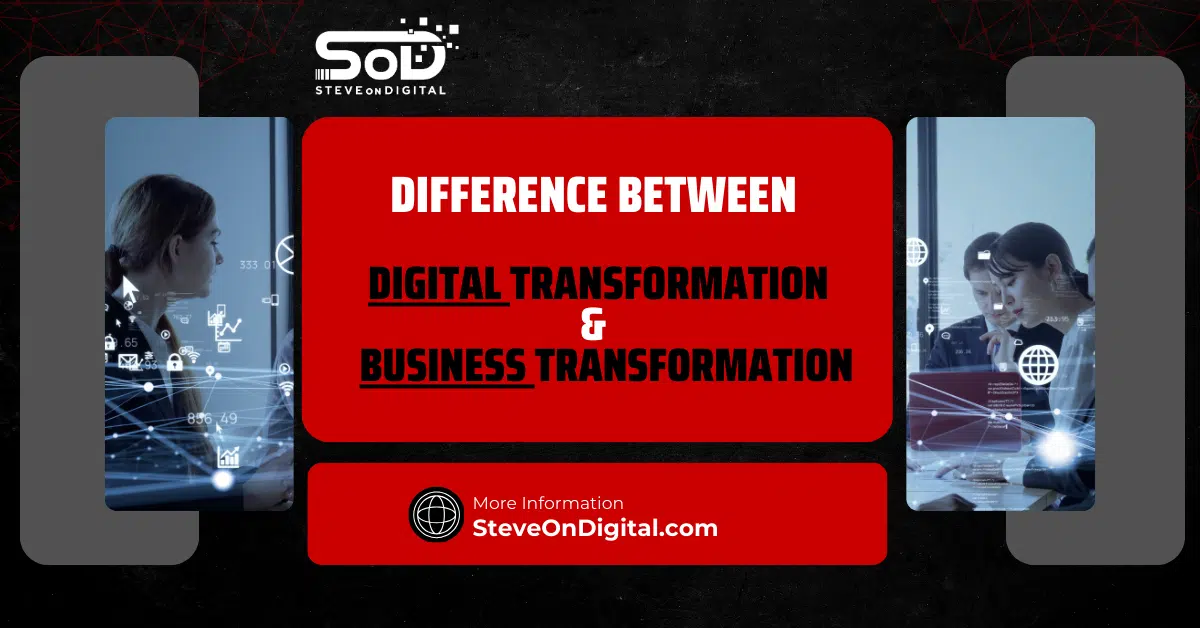Digital transformation challenges include legacy systems, skills gaps, and security concerns. Solutions involve strategic planning, skill development, and robust cybersecurity measures.
I am a Digital Transformation Specialist with a background in electrical engineering, an MBA, and a master’s in Project Management. I assist small and medium-sized businesses (SMEs) in navigating the digital landscape, offering practical advice and insights from real-life scenarios.
Introduction To Digital Transformation
Digital transformation is more than a buzzword; it’s a vital process for every business to stay relevant. It means using digital technology in every part of your business. This changes how you run your business and how you provide value to customers. Leveraging digital solutions improves efficiency, productivity, and competitiveness. Embracing digital transformation is crucial to avoid falling behind. I’ve experienced the highs and lows of digital transformation, and while the journey is challenging, the rewards are immense.
Overview Of Challenges And Solutions
Every digital transformation journey comes with its set of hurdles. These challenges range from technical issues to cultural resistance within the organization. However, each challenge also presents an opportunity for growth and improvement. Here’s a brief overview of what we’ll tackle:
- Key Challenges: Legacy systems, skills gap, change management, security concerns, budget constraints, and technology integration.
- Solutions: Strategic planning, skill development, robust cybersecurity measures, leveraging cloud solutions, effective change management, and careful budgeting.
Understanding Digital Transformation
Definition And Scope
Digital transformation means using new digital tools to change how a business works, its culture, and how it interacts with customers to keep up with changing business and market needs. This transformation transcends traditional roles like sales, marketing, and customer service. Instead, digital transformation begins and ends with how you think about and engage with customers.
Key components include:
- Digital Tools and Technologies: Implementing new digital solutions and integrating them with existing systems.
- Processes: Re-engineering business processes for greater efficiency.
- Culture: Shifting organizational culture to embrace continuous digital innovation.
Importance In The Digital Age
In today’s digital age, businesses must transform to remain competitive. Customers expect seamless digital experiences, and companies that fail to deliver will quickly find themselves outpaced by more agile competitors.
Benefits Of Successful Transformation:
- Increased Efficiency: Automation and data analytics streamline operations.
- Improved Customer Experience: Personalized and consistent customer interactions.
- Enhanced Decision-Making: Real-time insights from data analytics.
- Greater Agility: Ability to adapt quickly to market changes.
Key Challenges In Digital Transformation
Legacy Systems
Issues With Outdated Systems
Dealing with legacy systems is one of the most significant digital transformation challenges. These systems are often outdated, inflexible, and incompatible with new digital technologies. As a result, they can hinder your efforts to modernize and streamline operations. I’ve worked with several small businesses where outdated systems caused major roadblocks, slowing down their entire digital transformation journey.
Transitioning To Modern Systems
The transition from legacy systems to modern digital solutions can be complex and costly. However, it’s a necessary step to stay competitive. I recommend a phased approach where you gradually replace old systems with new digital tools. For instance, start with the most critical systems and move towards less critical ones. This minimizes disruption and spreads the cost over time.
Digital Skills Gap
Identifying The Skill Shortage
The digital skills gap is another significant challenge. Many small businesses struggle to find employees with the necessary digital expertise. In my experience, this gap often stems from rapid technological advancements outpacing the skills of the existing workforce.
Solutions For Skill Development
To overcome this, investing in training programs is crucial. Upskilling your current employees can be more cost-effective than hiring new staff. Additionally, consider partnering with local educational institutions to develop specialized training programs. I’ve seen businesses benefit greatly from internships and apprenticeships that bring fresh, tech-savvy talent into the organization.
Change Management
Resistance To Change
Resistance to change is a natural human response, and it’s a common hurdle in digital transformation. Employees may fear job loss or feel overwhelmed by new technologies. This resistance can significantly slow down the transformation process.
Strategies For Effective Change Management
Effective change management is key. Communicate the benefits of digital transformation clearly and involve employees in the process. I’ve found that providing comprehensive training and continuous support helps in easing the transition. Leadership should actively champion the transformation, setting a positive example for the rest of the organization.
Security Concerns
Cybersecurity Risks
Introducing new digital technologies can expose your business to cybersecurity risks. Cyberattacks can result in data breaches, financial loss, and damage to your reputation.
Implementing Security Measures
Implementing robust security measures is essential. You can take steps like doing regular security checks, teaching employees about cybersecurity best practices, and spending money on better cybersecurity tools. In my experience, outsourcing cybersecurity to experts can provide an additional layer of protection and peace of mind.
Cost And Budget Constraints
Financial Challenges
Digital transformation can be expensive, and managing these costs is a significant challenge, especially for small businesses.
Cost-Effective Solutions
Careful financial planning and prioritizing digital investments can help manage costs. Look for scalable and flexible digital solutions that grow with your business. Cloud-based services, for example, often offer affordable, pay-as-you-go pricing models. This approach allows you to spread costs over time, making it easier to budget for your transformation efforts.
Integration Of New Technologies
Compatibility Issues
Integrating new digital technologies with existing systems can be a daunting task. Compatibility issues can lead to disruptions and inefficiencies.
Solutions For Seamless Integration
Start small and scale gradually. Test new technologies in a controlled environment before full implementation. This approach minimizes risk and ensures compatibility. Working with experienced digital transformation consultants can also facilitate a smoother integration process.
Solutions For Overcoming Digital Transformation Challenges
Developing A Digital Transformation Strategy
Key Elements Of A Strategy
A well-defined digital transformation strategy is essential. This strategy should outline your goals, the technologies you plan to implement, and the steps you’ll take to achieve your objectives.
Steps To Develop An Effective Strategy
- Assess Current State: Evaluate your existing systems and processes.
- Define Goals: Set clear, measurable objectives for your transformation.
- Plan Technology Investments: Identify the digital tools and technologies you need.
- Develop a Roadmap: Create a timeline for implementation, with milestones and checkpoints.
| Step | Description |
| Assess Current State | Evaluate existing systems, processes, and technologies. |
| Define Goals | Set clear, measurable objectives for the transformation. |
| Plan Technology Investments | Identify necessary digital tools and technologies. |
| Develop a Roadmap | Create a timeline with milestones and checkpoints. |
Investing In Digital Skills
Training Programs
Investing in training programs for your current employees is crucial. Focus on developing skills that are essential for your digital transformation.
Hiring Specialized Skills
In some cases, hiring specialists may be necessary. Look for candidates with expertise in the technologies and processes you plan to implement. I’ve found that blending in-house training with external hiring creates a balanced approach to building a digitally skilled workforce.
Enhancing Cybersecurity
Best Practices For Cybersecurity
Adopting best practices for cybersecurity is non-negotiable. Regular updates, strong passwords, and multi-factor authentication are basic steps.
Role Of Cybersecurity Frameworks
Implementing recognized cybersecurity frameworks, such as NIST or ISO 27001, provides a structured approach to managing cybersecurity risks. These frameworks offer guidelines and best practices that can help protect your business from cyber threats.
Utilizing Cloud Solutions
Benefits Of Cloud Computing
Cloud computing offers numerous benefits, including cost savings, scalability, and flexibility. It allows you to access resources on demand, paying only for what you use.
| Benefit | Description |
| Cost Savings | Reduces upfront capital expenditure. |
| Scalability | Easily scales resources up or down based on demand. |
| Flexibility | Access resources and applications from anywhere. |
| Disaster Recovery | Provides robust backup and recovery solutions. |
Selecting The Right Cloud Service
Choosing the right cloud service is critical. Consider factors such as cost, security, and compatibility with your existing systems. I recommend starting with a small pilot project to evaluate the service before a full-scale rollout.
Implementing Change Management
Techniques For Managing Change
Effective change management involves clear communication, employee involvement, and ongoing support. Provide training and resources to help employees adapt to new technologies.
Importance Of Leadership And Communication
Strong leadership and transparent communication are vital. Leaders should actively support the transformation and communicate its benefits to the entire organization. In my experience, this helps build trust and reduces resistance to change.
Budgeting For Digital Transformation
Financial Planning
Careful financial planning is essential. Develop a comprehensive budget that includes all anticipated costs, from technology investments to training programs.
Leveraging Financial Resources
Look for ways to leverage financial resources, such as government grants or incentives for digital transformation. These can provide additional funding to support your efforts.
Digital Transformation Journey
Planning And Initiating Transformation
Initial Steps
Starting your digital transformation journey can seem overwhelming. The first step is to assess your current state. Identify outdated systems and processes that need modernization. In my experience, a thorough assessment helps set a clear path for transformation. Next, engage key stakeholders from different departments. Their input is crucial for a comprehensive understanding of the existing challenges and opportunities.
Setting Goals And Milestones
Setting clear, achievable goals is essential. Outline what you want to accomplish with your digital transformation programs. Break these goals down into smaller milestones to track progress effectively. For example, if your goal is to improve customer experience, set milestones like implementing a new CRM system or launching a customer feedback platform.
Executing Digital Initiatives
Implementation Process
Once you have a plan, the next step is executing digital initiatives. Start by prioritizing projects that offer the most significant impact. From my experience, it’s beneficial to begin with pilot projects to test new digital solutions before a full-scale rollout. This approach minimizes risk and provides valuable insights for larger implementations.
Monitoring Progress
Monitoring progress is critical to ensure your digital transformation stays on track. Use project management tools to keep track of tasks, deadlines, and resources. Regular check-ins and progress reports help identify issues early and keep everyone aligned with the goals.
Measuring Success
Key Performance Indicators (KPIs)
Measuring the success of your digital transformation initiatives is essential. Establish key performance indicators (KPIs) to track your progress. Common KPIs include customer satisfaction scores, operational efficiency metrics, and revenue growth. These indicators provide a clear picture of how well your initiatives are performing.
| KPI | Description | Metric Examples |
| Customer Satisfaction | Measures how satisfied customers are with products/services. | Net Promoter Score (NPS), Customer Satisfaction Score (CSAT). |
| Operational Efficiency | Assesses the efficiency of business processes. | Process cycle time, resource utilization rate. |
| Revenue Growth | Tracks the increase in revenue over time. | Year-over-Year (YoY) growth, Monthly Recurring Revenue (MRR). |
| Digital Adoption Rate | Measures how quickly new digital tools are adopted by employees. | Percentage of tool usage, number of active users. |
Continuous Improvement
Digital transformation is an ongoing process. Regularly review your progress and make necessary adjustments. Continuous improvement ensures that your digital transformation remains relevant and effective in a rapidly changing digital landscape. For instance, I often revisit strategies and tools to ensure they align with evolving business goals and market trends.
Role Of Digital Tools And Technologies
Data Analytics
Importance Of Data Analytics
Data analytics plays a crucial role in digital transformation. It helps businesses make informed decisions based on real-time data. For example, data analytics can identify customer behavior patterns, optimize supply chains, and predict market trends. In my experience, leveraging data analytics has been a game-changer for improving business outcomes.
Tools And Techniques
There are various tools and techniques available for data analytics. Popular tools include Google Analytics, Tableau, and Power BI. These tools help visualize data, making it easier to understand and act upon. Techniques such as predictive analytics and machine learning can provide deeper insights and drive innovation.
Automation
Benefits Of Automation
Automation streamlines business processes, reduces errors, and improves efficiency. For small businesses, automating repetitive tasks frees up valuable time and resources. For instance, automating customer service responses or inventory management can significantly enhance productivity.
Implementing Automation Tools
Implementing automation tools requires careful planning. Identify tasks that can be automated and choose the right tools. Popular automation tools include Zapier for workflow automation and UiPath for robotic process automation (RPA). Start with small-scale implementations and gradually expand to more complex processes.
Artificial Intelligence And Machine Learning
Use Cases In Business
Artificial intelligence (AI) and machine learning (ML) are transforming various industries. Use cases include personalized marketing, fraud detection, and predictive maintenance. In my practice, using AI for customer segmentation has improved marketing effectiveness significantly.
Integration Strategies
Integrating AI and ML into your business requires a strategic approach. Start by identifying areas where AI can add the most value. Then, invest in the necessary infrastructure and talent. Collaboration with AI specialists or consultants can also help ensure successful integration.
Industry-Specific Challenges And Solutions
Small And Medium-Sized Enterprises (Smes)
Unique Challenges For Smes
SMEs face unique challenges in digital transformation, such as limited resources and digital skills gap. Often, these businesses struggle to keep up with rapid technological advancements.
Tailored Solutions For Smes
Tailored solutions for SMEs include leveraging cloud-based services and outsourcing IT functions. In my experience, cloud solutions offer flexibility and scalability without significant upfront investment. Additionally, partnering with digital transformation consultants can provide the expertise needed to overcome these challenges.
Large Enterprises
Challenges Faced By Large Enterprises
Large enterprises face different challenges, such as complex legacy systems and resistance to change. These organizations often have more stakeholders, making the transformation process more complicated.
Solutions For Large-Scale Transformations
Solutions for large-scale transformations include developing a comprehensive digital transformation strategy and implementing change management strategies. Engaging a digital transformation consultant can also help navigate the complexities of large-scale projects.
Case Studies And Real-Life Examples
Successful Digital Transformations
Examples From Various Industries
Successful digital transformations can be seen across various industries. For instance, retail giant Walmart implemented data analytics to optimize its supply chain, resulting in significant cost savings and improved efficiency. Similarly, healthcare providers use digital tools to enhance patient care and streamline operations.
Key Takeaways And Lessons Learned
Key takeaways from these success stories include the importance of a clear strategy, stakeholder engagement, and continuous improvement. Learning from these examples can provide valuable insights for your own digital transformation journey.
Failed Transformations And What To Avoid
Common Pitfalls
Not all digital transformations are successful. Common pitfalls include lack of clear strategy, insufficient stakeholder buy-in, and inadequate resources. I’ve seen businesses struggle due to underestimating the complexity of integration or failing to address cultural resistance.
Strategies To Avoid Failure
To avoid these pitfalls, develop a thorough change management strategy and prioritize digital investments. Regularly review and adjust your strategy based on feedback and performance metrics. Engaging with digital transformation consultants can also provide expert guidance and increase the likelihood of success.
| Common Pitfall | Description | Strategy to Avoid Failure |
| Lack of Clear Strategy | No defined goals or roadmap for transformation. | Develop a detailed digital transformation strategy. |
| Insufficient Stakeholder Buy-In | Lack of support from key stakeholders. | Engage stakeholders early and communicate benefits clearly. |
| Inadequate Resources | Not enough budget, time, or skills allocated. | Prioritize digital investments and provide necessary training. |
| Underestimating Complexity | Misjudging the challenges of integrating new technologies. | Start with pilot projects and scale gradually. |
Future Trends In Digital Transformation
Emerging Technologies
Future Tech Trends
The future of digital transformation is being shaped by emerging technologies. Innovations such as artificial intelligence (AI), machine learning, blockchain, and the Internet of Things (IoT) are set to revolutionize how businesses operate. For example, AI and machine learning are already enhancing decision-making processes and automating tasks that once required human intervention. Blockchain is improving transparency and security in transactions, while IoT is connecting devices to streamline operations and gather valuable data.
| Technology | Description | Impact on Businesses |
| Artificial Intelligence | Machines simulating human intelligence processes. | Enhances decision-making, automates tasks, personalizes marketing. |
| Machine Learning | Algorithms improving automatically through experience. | Predictive analytics, customer segmentation, improves operations. |
| Blockchain | Decentralized digital ledger technology. | Increases transparency, security, and efficiency in transactions. |
| Internet of Things (IoT) | Network of connected devices sharing data. | Optimizes supply chains, improves maintenance, enhances customer experiences. |
According to a recent report by Gartner, spending on AI is projected to reach $190 billion by 2025, highlighting its growing importance in business strategies. As I’ve seen in my work, businesses that adopt these technologies early gain a significant competitive advantage.
Impact On Businesses
The impact of these technologies on businesses is profound. They not only improve efficiency and productivity but also open up new revenue streams and business models. For instance, predictive analytics powered by AI can help businesses anticipate market trends and customer needs, allowing for more strategic planning and marketing efforts.
Moreover, IoT devices provide real-time data that can optimize supply chains, reduce downtime in manufacturing, and enhance customer experiences. In my experience, businesses that leverage these technologies can better meet customer expectations and adapt quickly to market changes.
Evolution Of Digital Strategies
Adapting To Future Changes
Digital strategies must evolve to keep pace with technological advancements and market dynamics. This means staying informed about emerging trends and being flexible enough to adapt your strategies as needed. A successful digital transformation strategy is not a one-time effort but an ongoing process that requires continuous evaluation and adjustment.
One approach I recommend is to adopt a proactive monitoring strategy. This involves regularly assessing the effectiveness of your digital initiatives and making necessary adjustments. Keeping an eye on industry trends and competitor activities can also provide valuable insights that inform your strategy.
Long-Term Planning
Long-term planning is crucial for sustainable digital transformation. This involves setting clear, long-term goals and developing a comprehensive roadmap to achieve them. It’s essential to prioritize digital investments that align with your business objectives and deliver measurable results.
In my experience, businesses that engage in thorough change management strategy and prioritize digital investments are better positioned to navigate the complexities of digital transformation. Developing a solid implementation plan that includes milestones and KPIs can help track progress and ensure that your transformation efforts remain on course.
Practical Tips For Business Leaders
Leadership In Digital Transformation
Role Of Leadership
Leadership plays a critical role in digital transformation. As a business leader, your support and commitment are vital to the success of your digital initiatives. Leaders must champion the transformation, communicate its benefits clearly to all stakeholders, and foster a culture of innovation and continuous improvement.
In my journey, I’ve found that maintaining transparent communication and actively involving employees in the transformation process helps build trust and reduce resistance to change.
Leadership Skills For Transformation
Effective leadership skills are essential for guiding your organization through digital transformation. This includes strategic thinking, decision-making, and the ability to inspire and motivate your team. Leaders should also be adaptable and open to new ideas, as the digital landscape is constantly evolving.
Developing these skills can be achieved through continuous learning and professional development. Engaging with digital transformation consultants or attending relevant workshops and conferences can also provide valuable insights and enhance your leadership capabilities.
Building A Digital Culture
Creating A Digital-First Mindset
Building a digital culture starts with creating a digital-first mindset within your organization. This means prioritizing digital solutions and encouraging employees to embrace new technologies. It’s important to communicate the benefits of digital transformation clearly and provide the necessary training and resources to support your team.
In my practice, I’ve seen that businesses that foster a digital-first culture are more agile and better equipped to respond to market changes.
Encouraging Innovation
Encouraging innovation is key to a successful digital transformation. Create an environment where employees feel empowered to experiment with new ideas and technologies. Encourage collaboration and cross-functional teamwork to drive innovation and problem-solving.
Implementing incentive programs can also motivate employees to contribute to your digital transformation initiatives. Recognizing and rewarding innovative ideas and successful projects can boost morale and foster a culture of continuous improvement.
Final Thoughts
Summary Of Key Points
To recap, digital transformation is essential for staying competitive in today’s digital age. It involves integrating digital technologies into all areas of your business, which comes with its own set of challenges and solutions. Key challenges include legacy systems, digital skills gap, change management, security concerns, cost constraints, and technology integration.
By developing a comprehensive digital transformation strategy, investing in digital skills, enhancing cybersecurity, leveraging cloud solutions, and implementing effective change management, you can overcome these challenges and achieve a successful transformation.
Encouragement For Businesses
Digital transformation is a journey, not a destination. While the path may be challenging, the rewards are worth the effort. As I’ve experienced, businesses that embrace digital transformation can achieve significant growth and a competitive edge.
Moving forward with confidence and a clear strategy will enable you to navigate the digital landscape successfully. Stay informed about emerging trends, be flexible in your approach, and continuously seek ways to innovate and improve. Your commitment to digital transformation will position your business for long-term success in the digital era.




